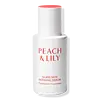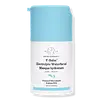What's inside
What's inside
 Key Ingredients
Key Ingredients

 Benefits
Benefits

 Concerns
Concerns

 Ingredients Side-by-side
Ingredients Side-by-side

Water
Skin ConditioningPropanediol
SolventButylene Glycol
HumectantNiacinamide
Smoothing1,2-Hexanediol
Skin ConditioningPrunus Persica Fruit Extract
AbrasiveDioscorea Japonica Root Extract
Skin ConditioningSodium Hyaluronate
HumectantAdenosine
Skin ConditioningHydrolyzed Sodium Hyaluronate
Skin ConditioningMadecassoside
AntioxidantHydrolyzed Hyaluronic Acid
HumectantSodium Acetylated Hyaluronate
HumectantAcetyl Octapeptide-3
HumectantEthylhexylglycerin
Skin ConditioningHydrolyzed Corn Starch
HumectantSodium Carbomer
Emulsion StabilisingBeta-Glucan
Skin ConditioningSaccharide Isomerate
HumectantPhytic Acid
Sucrose
HumectantAsiaticoside
AntioxidantCaprylyl Glycol
EmollientWater, Propanediol, Butylene Glycol, Niacinamide, 1,2-Hexanediol, Prunus Persica Fruit Extract, Dioscorea Japonica Root Extract, Sodium Hyaluronate, Adenosine, Hydrolyzed Sodium Hyaluronate, Madecassoside, Hydrolyzed Hyaluronic Acid, Sodium Acetylated Hyaluronate, Acetyl Octapeptide-3, Ethylhexylglycerin, Hydrolyzed Corn Starch, Sodium Carbomer, Beta-Glucan, Saccharide Isomerate, Phytic Acid, Sucrose, Asiaticoside, Caprylyl Glycol
Water
Skin ConditioningSqualane
EmollientPropanediol
SolventNiacinamide
SmoothingOlive Oil Glycereth-8 Esters
EmollientCoconut Alkanes
EmollientCocos Nucifera Water
MaskingSimmondsia Chinensis Seed Oil
EmollientAmmonium Acryloyldimethyltaurate/Vp Copolymer
Glycerin
HumectantMannitol
HumectantSclerocarya Birrea Seed Oil
HumectantSclerocarya Birrea Seed Butter
EmollientSodium PCA
HumectantOpuntia Tuna Fruit Extract
Skin ConditioningLinum Usitatissimum Seed Oil
PerfumingSorbitol
HumectantQuercetin
AntioxidantTrehalose
HumectantZea Mays Oil
EmulsifyingCetyl Alcohol
EmollientSucrose
HumectantCreatine
Skin ConditioningInositol
HumectantPentylene Glycol
Skin ConditioningFerulic Acid
AntimicrobialHydroxytyrosol
BleachingBehenic Acid
CleansingLinoleic Acid
CleansingCholesterol
EmollientCeramide Ns
Skin ConditioningCeramide AP
Skin ConditioningCeramide Eos
Skin ConditioningCeramide NP
Skin ConditioningCeramide EOP
Skin ConditioningPhospholipids
Skin ConditioningSodium Hyaluronate Crosspolymer
HumectantMagnesium PCA
HumectantMicrocrystalline Cellulose
AbsorbentAdenosine
Skin ConditioningSodium Hyaluronate
HumectantXanthan Gum
EmulsifyingCaprooyl Phytosphingosine
Skin ConditioningAscorbyl Palmitate
AntioxidantHydroxypropyl Methylcellulose
Emulsion StabilisingCaprooyl Sphingosine
Skin ConditioningCoco-Caprylate/Caprate
EmollientCeteareth-25
CleansingCitric Acid
BufferingGlyceryl Caprylate
EmollientPhenoxyethanol
PreservativeCaprylyl Glycol
EmollientSodium Benzoate
MaskingTocopherol
AntioxidantChlorphenesin
AntimicrobialPotassium Sorbate
PreservativeEthylhexylglycerin
Skin ConditioningWater, Squalane, Propanediol, Niacinamide, Olive Oil Glycereth-8 Esters, Coconut Alkanes, Cocos Nucifera Water, Simmondsia Chinensis Seed Oil, Ammonium Acryloyldimethyltaurate/Vp Copolymer, Glycerin, Mannitol, Sclerocarya Birrea Seed Oil, Sclerocarya Birrea Seed Butter, Sodium PCA, Opuntia Tuna Fruit Extract, Linum Usitatissimum Seed Oil, Sorbitol, Quercetin, Trehalose, Zea Mays Oil, Cetyl Alcohol, Sucrose, Creatine, Inositol, Pentylene Glycol, Ferulic Acid, Hydroxytyrosol, Behenic Acid, Linoleic Acid, Cholesterol, Ceramide Ns, Ceramide AP, Ceramide Eos, Ceramide NP, Ceramide EOP, Phospholipids, Sodium Hyaluronate Crosspolymer, Magnesium PCA, Microcrystalline Cellulose, Adenosine, Sodium Hyaluronate, Xanthan Gum, Caprooyl Phytosphingosine, Ascorbyl Palmitate, Hydroxypropyl Methylcellulose, Caprooyl Sphingosine, Coco-Caprylate/Caprate, Ceteareth-25, Citric Acid, Glyceryl Caprylate, Phenoxyethanol, Caprylyl Glycol, Sodium Benzoate, Tocopherol, Chlorphenesin, Potassium Sorbate, Ethylhexylglycerin
 Reviews
Reviews

Ingredients Explained
These ingredients are found in both products.
Ingredients higher up in an ingredient list are typically present in a larger amount.
Adenosine is in every living organism. It is one of four components in nucleic acids that helps store our DNA.
Adenosine has many benefits when used. These benefits include hydrating the skin, smoothing skin, and reducing wrinkles. Once applied, adenosine increases collagen production. It also helps with improving firmness and tissue repair.
Studies have found adenosine may also help with wound healing.
In skincare products, Adenosine is usually derived from yeast.
Learn more about AdenosineCaprylyl Glycol is a humectant and emollient, meaning it attracts and preserves moisture.
It is a common ingredient in many products, especially those designed to hydrate skin. The primary benefits are retaining moisture, skin softening, and promoting a healthy skin barrier.
Though Caprylyl Glycol is an alcohol derived from fatty acids, it is not the kind that can dry out skin.
This ingredient is also used as a preservative to extend the life of products. It has slight antimicrobial properties.
Learn more about Caprylyl GlycolEthylhexylglycerin (we can't pronounce this either) is commonly used as a preservative and skin softener. It is derived from glyceryl.
You might see Ethylhexylglycerin often paired with other preservatives such as phenoxyethanol. Ethylhexylglycerin has been found to increase the effectiveness of these other preservatives.
Niacinamide is a multitasking form of vitamin B3 that strengthens the skin barrier, reduces pores and dark spots, regulates oil, and improves signs of aging.
And the best part? It's gentle and well-tolerated by most skin types, including sensitive and reactive skin.
You might have heard of "niacin flush", or the reddening of skin that causes itchiness. Niacinamide has not been found to cause this.
In very rare cases, some individuals may not be able to tolerate niacinamide at all or experience an allergic reaction to it.
If you are experiencing flaking, irritation, and dryness with this ingredient, be sure to double check all your products as this ingredient can be found in all categories of skincare.
When incorporating niacinamide into your routine, look out for concentration amounts. Typically, 5% niacinamide provides benefits such as fading dark spots. However, if you have sensitive skin, it is better to begin with a smaller concentration.
When you apply niacinamide to your skin, your body converts it into nicotinamide adenine dinucleotide (NAD). NAD is an essential coenzyme that is already found in your cells as "fuel" and powers countless biological processes.
In your skin, NAD helps repair cell damage, produce new healthy cells, support collagen production, strengthen the skin barrier, and fight environmental stressors (like UV and pollution).
Our natural NAD levels start to decline with age, leading to slower skin repair, visible aging, and a weaker skin barrier. By providing your skin niacinamide, you're recharging your skin's NAD levels. This leads to stronger, healthier, and younger looking skin.
Another name for vitamin B3 is nicotinamide. This vitamin is water-soluble and our bodies don't store it. We obtain Vitamin B3 from either food or skincare. Meat, fish, wheat, yeast, and leafy greens contain vitamin B3.
The type of niacinamide used in skincare is synthetically created.
Learn more about NiacinamidePropanediol is an all-star ingredient. It softens, hydrates, and smooths the skin.
It’s often used to:
Propanediol is not likely to cause sensitivity and considered safe to use. It is derived from corn or petroleum with a clear color and no scent.
Learn more about PropanediolSodium Hyaluronate is hyaluronic acid's salt form. It is commonly derived from the sodium salt of hyaluronic acid.
Like hyaluronic acid, it is great at holding water and acts as a humectant. This makes it a great skin hydrating ingredient.
Sodium Hyaluronate is naturally occurring in our bodies and is mostly found in eye fluid and joints.
These are some other common types of Hyaluronic Acid:
Learn more about Sodium HyaluronateSucrose is a natural sugar found in fruits, vegetables, and nuts. It is the main constituent of white sugar.
In skincare, sucrose is a humectant and can be a mild exfoliant.
Sucrose is hydrophilic, meaning it attracts water. This makes it an effective humectant and helps hydrate the skin.
Studies show sugars may worsen acne-prone skin due to it disrupting the skin's natural biome. We recommend speaking with a professional if you have any concerns.
In some products such as body scrubs, sucrose is used as an gentle exfoliant.
The term 'sucrose' comes from the french word for sugar, 'sucre'.
Learn more about SucroseWater. It's the most common cosmetic ingredient of all. You'll usually see it at the top of ingredient lists, meaning that it makes up the largest part of the product.
So why is it so popular? Water most often acts as a solvent - this means that it helps dissolve other ingredients into the formulation.
You'll also recognize water as that liquid we all need to stay alive. If you see this, drink a glass of water. Stay hydrated!
Learn more about Water